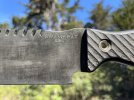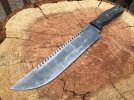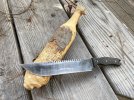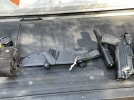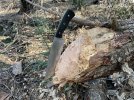Certainly done that.
The thing is though, not many folks consider batonning to make notches for traps, holders, or fitting structures together to be that controversial, if they think of it at all.
The thing that people think of when they hear "Batonning!" is some guy splitting huge firewood.
Not cross-grain batonning to accomplish a task, or splitting small diameter wood to get at the dry stuff.
Now have I done moronic chopping and batonning at times?
Yes.

Of course this was a huge knife I made of 5160 steel with a spine more than 0.300" thick, at 57 Rockwell for full indestructibility.

Even so I generally don't bother trying to split wood that huge with a knife because it takes more energy that it's worth, pretty much.
But we took the boat there, so energy was saved that way.
And doesn't this picture just look neat?
), but that was the first time I had seen a second piece of wood used to assist.



